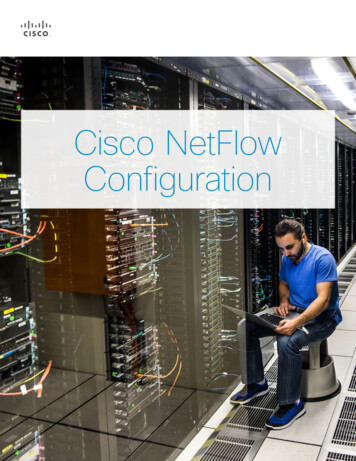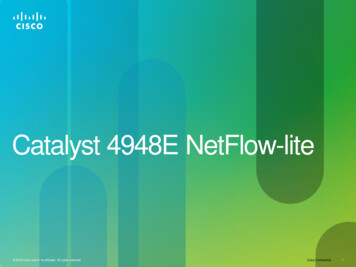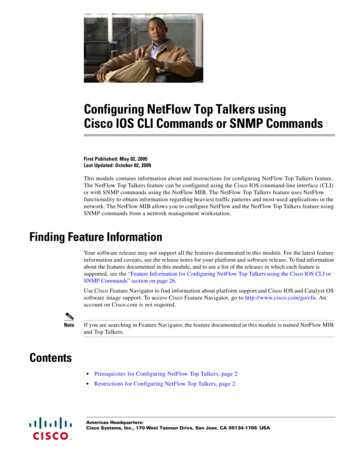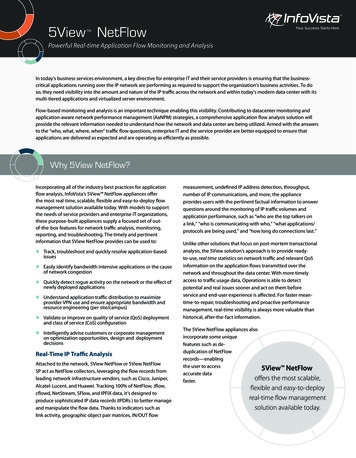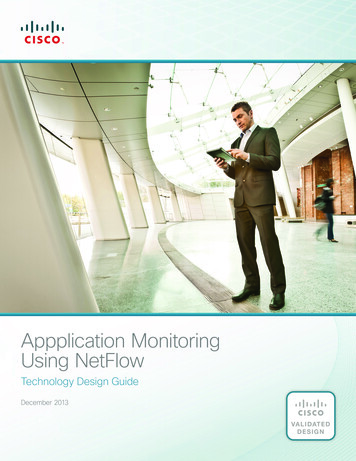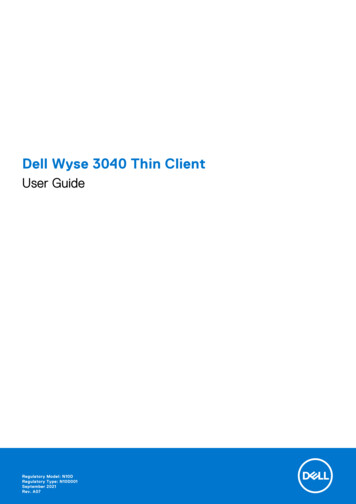
Transcription
S e n d d o c u m e n t c o m m e n t s t o n ex u s 1 k - d o c f e e d b a ck @ c i s c o . c o m .CH A P T E R11Configuring NetFlowUse this chapter to configure NetFlow to characterize IP traffic based on its source, destination, timing,and application information, to assess network availability and performance.This chapter includes the following sections: Information About NetFlow, page 11-1 Prerequisites for NetFlow, page 11-8 Configuration Guidelines and Limitations, page 11-9 Default Settings, page 11-9 Enabling the NetFlow Feature, page 11-10 Configuring NetFlow, page 11-11 Verifying the NetFlow Configuration, page 11-21 Configuration Example for NetFlow, page 11-25 Additional References, page 11-26 Feature History for NetFlow, page 11-27Information About NetFlowNetFlow lets you evaluate IP traffic and understand how and where it flows. NetFlow gathers data thatcan be used in accounting, network monitoring, and network planning.This section includes the following topics: What is a Flow, page 11-2 Flow Record Definition, page 11-2 Accessing NetFlow Data, page 11-5 Exporting Flows to the NetFlow Collector Server, page 11-7 What NetFlow Data Looks Like, page 11-8 High Availability, page 11-8Cisco Nexus 1000V System Management Configuration Guide, Release 4.2(1) SV1(4a)OL-22824-A111-1
Chapter 11Configuring NetFlowInformation About NetFlowSe n d d o c u m e n t c o m m e n t s t o n ex u s 1 k - d o c f e e d b a ck @ c i s c o . c o m .What is a FlowA flow is a one-directional stream of packets that arrives on a source interface (or subinterface),matching a set of criteria. All packets with the same source/destination IP address, source/destinationports, protocol interface and class of service are grouped into a flow and then packets and bytes aretallied. This condenses a large amount of network information into a database called the NetFlow cache.Figure 11-1Creating a Flow in the NetFlow CacheYou create a flow by defining the criteria it gathers. Flows are stored in the NetFlow cache.Flow information tells you the following: Source address tells you who is originating the traffic. Destination address tells who is receiving the traffic. Ports characterize the application using the traffic. Class of service examines the priority of the traffic. The device interface tells how traffic is being used by the network device. Tallied packets and bytes show the amount of traffic.Flow Record DefinitionA flow record defines the information that NetFlow gathers, such as packets in the flow and the types ofcounters gathered per flow. You can define new flow records or use the pre-defined Cisco Nexus 1000Vflow record.To create a record, see the “Defining a Flow Record” procedure on page 11-11.Cisco Nexus 1000V System Management Configuration Guide, Release 4.2(1) SV1(4a)11-2OL-22824-A1
Chapter 11Configuring NetFlowInformation About NetFlowS e n d d o c u m e n t c o m m e n t s t o n ex u s 1 k - d o c f e e d b a ck @ c i s c o . c o m .The following table describes the criteria defined in a flow record.Flow record criteriaDescriptionMatchDefines what information is matched for collection in the flow record. ip: Data collected in the flow record matches one of the followingIP options:– protocol– tos (type of service) ipv4: Data collected in the flow record matches one of the followingipv4 address options:– source address– destination adress transport: Data collected in the flow record matches one of thefollowing transport options:– destination port– source portCollectDefines how the flow record collects information. counter: Collects Flow Record information in one of the followingformats:– bytes: collected in 32-bit counters unless the long 64-bitcounter is specified.– packets: collected in 32-bit counters unless the long 64-bitcounter is specified. timestamp sys-uptime: Collects the system up time for the first orlast packet in the flow. transport tcp flags: Collects the TCP transport layer flags for thepackets in the flow.Predefined Flow RecordsCisco Nexus 1000V includes the following pre-defined flow records. Example 11-1Cisco Nexus 1000V Predefined Flow Record: Netflow-Original, page 11-3 Example 11-2Cisco Nexus 1000V Predefined Flow Record: Netflow IPv4 Original-Input, page 11-4 Example 11-3Cisco Nexus 1000V Predefined Flow Record: Netflow IPv4 Original-Output,page 11-4 Example 11-4Cisco Nexus 1000V Predefined Flow Record: Netflow Protocol-Port, page 11-5Example 11-1 Cisco Nexus 1000V Predefined Flow Record: Netflow-Originaln1000v# show flow record netflow-originalFlow record netflow-original:Description: Traditional IPv4 input NetFlow with origin ASsNo. of users: 0Template ID: 0Cisco Nexus 1000V System Management Configuration Guide, Release 4.2(1) SV1(4a)OL-22824-A111-3
Chapter 11Configuring NetFlowInformation About NetFlowSe n d d o c u m e n t c o m m e n t s t o n ex u s 1 k - d o c f e e d b a ck @ c i s c o . c o m .Fields:match ipv4 source addressmatch ipv4 destination addressmatch ip protocolmatch ip tosmatch transport source-portmatch transport destination-portmatch interface inputmatch interface outputmatch flow directioncollect routing source ascollect routing destination ascollect routing next-hop address ipv4collect transport tcp flagscollect counter bytescollect counter packetscollect timestamp sys-uptime firstcollect timestamp sys-uptime lastn1000v#NoteAlthough the following lines appear in the output of the show flow record command, thecommands they are based on are not currently supported in Cisco Nexus 1000V. The use of thesecommands has no affect on the configuration.collect routing source ascollect routing destination ascollect routing next-hop address ipv4Example 11-2 Cisco Nexus 1000V Predefined Flow Record: Netflow IPv4 Original-Inputn1000v# show flow record netflow ipv4 original-inputFlow record ipv4 original-input:Description: Traditional IPv4 input NetFlowNo. of users: 0Template ID: 0Fields:match ipv4 source addressmatch ipv4 destination addressmatch ip protocolmatch ip tosmatch transport source-portmatch transport destination-portmatch interface inputmatch interface outputmatch flow directioncollect routing source ascollect routing destination ascollect routing next-hop address ipv4collect transport tcp flagscollect counter bytescollect counter packetscollect timestamp sys-uptime firstcollect timestamp sys-uptime lastn1000v#Example 11-3 Cisco Nexus 1000V Predefined Flow Record: Netflow IPv4 Original-Outputswitch# show flow record netflow ipv4 original-outputCisco Nexus 1000V System Management Configuration Guide, Release 4.2(1) SV1(4a)11-4OL-22824-A1
Chapter 11Configuring NetFlowInformation About NetFlowS e n d d o c u m e n t c o m m e n t s t o n ex u s 1 k - d o c f e e d b a ck @ c i s c o . c o m .Flow record ipv4 original-output:Description: Traditional IPv4 output NetFlowNo. of users: 0Template ID: 0Fields:match ipv4 source addressmatch ipv4 destination addressmatch ip protocolmatch ip tosmatch transport source-portmatch transport destination-portmatch interface inputmatch interface outputmatch flow directioncollect routing source ascollect routing destination ascollect routing next-hop address ipv4collect transport tcp flagscollect counter bytescollect counter packetscollect timestamp sys-uptime firstcollect timestamp sys-uptime lastswitch#Example 11-4 Cisco Nexus 1000V Predefined Flow Record: Netflow Protocol-Portswitch# show flow record netflow protocol-portFlow record ipv4 protocol-port:Description: Protocol and Ports aggregation schemeNo. of users: 0Template ID: 0Fields:match ip protocolmatch transport source-portmatch transport destination-portmatch interface inputmatch interface outputmatch flow directioncollect counter bytescollect counter packetscollect timestamp sys-uptime firstcollect timestamp sys-uptime lastswitch#Accessing NetFlow DataThere are two primary methods used to access NetFlow data: Command Line Interface (CLI), page 11-5 NetFlow Collector, page 11-6Command Line Interface (CLI)To view what is happening in your network now, use the CLI. To see a list of available show commands,see the “Verifying the NetFlow Configuration” section on page 11-21.Cisco Nexus 1000V System Management Configuration Guide, Release 4.2(1) SV1(4a)OL-22824-A111-5
Chapter 11Configuring NetFlowInformation About NetFlowSe n d d o c u m e n t c o m m e n t s t o n ex u s 1 k - d o c f e e d b a ck @ c i s c o . c o m .The CLI uses the following tools to capture and export flow records to the Netflow Collector: Flow Monitor, page 11-6 Flow Exporter, page 11-6Flow MonitorA flow monitor creates an association between the following NetFlow components: a flow record—consisting of matching and collection criteria a flow exporter—consisting of the export criteriaThis flow monitor association enables a set, consisting of a record and an exporter, to be defined onceand re-used many times. Multiple flow monitors can be created for different needs. A flow monitor isapplied to a specific interface in a specific direction.See the “Defining a Flow Monitor” procedure on page 11-16, and “Assigning a Flow Monitor to anInterface” procedure on page 11-19.Flow ExporterUse the flow exporter to define where and when the flow records are sent from the cache to the reportingserver, called the NetFlow Collector.An exporter definition includes the following.Note Destination IP address Source interface UDP port number (where the collector is listening) Export formatNetFlow export packets use the IP address assigned to the source interface. If the source interface doesnot have an IP address assigned to it, the exporter will be inactive.See the “Defining a Flow Exporter” procedure on page 11-14.Export FormatsCisco Nexus 1000V supports the NetFlow Version 9 export format.NoteCisco Nexus 1000V supports UDP as the transport protocol for exporting data to up to two exporters permonitor.NetFlow CollectorYou can export NetFlow from the Cisco Nexus 1000V NetFlow cache to a reporting server called theNetFlow Collector. The NetFlow Collector assembles the exported flows and combines them to producereports used for traffic and security analysis. NetFlow export, unlike SNMP polling, pushes informationperiodically to the NetFlow reporting collector. The NetFlow cache is constantly filling with flows.Cisco Nexus 1000V System Management Configuration Guide, Release 4.2(1) SV1(4a)11-6OL-22824-A1
Chapter 11Configuring NetFlowInformation About NetFlowS e n d d o c u m e n t c o m m e n t s t o n ex u s 1 k - d o c f e e d b a ck @ c i s c o . c o m .Cisco Nexus 1000V searches the cache for flows that have terminated or expired and exports them to theNetFlow collector server. Flows are terminated when the network communication has ended, that is,when a packet contains the TCP FIN flag.The following steps implement NetFlow data reporting: NetFlow records are configured to define the information that NetFlow gathers. Netflow monitor is configured to capture flow records to the NetFlow cache. NetFlow export is configured to send flows to the collector. Cisco Nexus 1000V searches the NetFlow cache for flows that have terminated and exports them tothe NetFlow collector server. Flows are bundled together based on space availability in the UDP export packet or based on exporttimer. The NetFlow collector software creates real-time or historical reports from the data.Exporting Flows to the NetFlow Collector ServerTimers determine when a flow is exported to the NetFlow Collector Server.A flow is ready for export when one of the following occurs: The flow is inactive for a certain time during which no new packets are received for the flow. The flow has lived longer than the active timer, for example, a long FTP download. A TCP flag indicates the flow is terminated. That is, a FIN or RST flag is present. The flow cache is full and some flows must be aged out to make room for new flows.Figure 11-2Exporting Flows to the NetFlow Collector ServerCisco Nexus 1000V System Management Configuration Guide, Release 4.2(1) SV1(4a)OL-22824-A111-7
Chapter 11Configuring NetFlowPrerequisites for NetFlowSe n d d o c u m e n t c o m m e n t s t o n ex u s 1 k - d o c f e e d b a ck @ c i s c o . c o m .What NetFlow Data Looks LikeThe following figure shows an example of NetFlow data.Figure 11-3NetFlow Cache ExampleNetwork Analysis ModuleYou can also use the Cisco Network Analysis Module (NAM) to monitor NetFlow data sources. NAMenables traffic analysis views and reports such as hosts, applications, conversations, VLAN, and QoS.To use NAM for monitoring the Cisco Nexus 1000V NetFlow data sources see the Cisco Nexus 1010Network Analysis Module Installation and Configuration Note, 4.2.High AvailabilityCisco Nexus 1000V supports stateful restarts for NetFlow. After a reboot or supervisor switchover, CiscoNexus 1000V applies the running configuration.Prerequisites for NetFlow You must be aware of resource requirements since NetFlow consumes additional memory and CPUresources. Memory and CPU resources are provided by the VEM hosting the flow monitor interface. Resourcesare limited by the number of CPU cores present on the VEM.Cisco Nexus 1000V System Management Configuration Guide, Release 4.2(1) SV1(4a)11-8OL-22824-A1
Chapter 11Configuring NetFlowConfiguration Guidelines and LimitationsS e n d d o c u m e n t c o m m e n t s t o n ex u s 1 k - d o c f e e d b a ck @ c i s c o . c o m .Configuration Guidelines and LimitationsNetFlow has the following configuration guidelines and limitations: If a source interface is not configured, the NetFlow exporter will remain disabled. In Cisco Nexus 1000V, Mgmt0 interface is configured by default as the source interface for anexporter. You can change the source interface if needed. Cisco Nexus 1000V includes the following predefined flow records that can be used instead ofconfiguring a new one. For more information, see the “Flow Record Definition” section onpage 11-2:– netflow-originalCisco Nexus 1000V predefined traditional IPv4 input NetFlow with origin ASsNoteThe routing-related fields in this predefined flow record are ignored.– netflow ipv4 original-inputCisco Nexus 1000V predefined traditional IPv4 input NetFlow– netflow ipv4 original-outputCisco Nexus 1000V predefined traditional IPv4 output NetFlow– netflow protocol-portCisco Nexus 1000V predefined protocol and ports aggregation scheme Up to 256 NetFlow interfaces are allowed per DVS. Up to 32 NetFlow interfaces are allowed per host A maximum of one flow monitor per interface per direction is allowed. Up to 8 flow monitors are allowed per VEM. Up to 2 flow exporters are permitted per monitor. Up to 32 NetFlow Policies are allowed per DVS. Up to 8 NetFlow Policies are allowed per host. NetFlow is not supported on port channels.Default SettingsTable 11-1 lists the default settings for NetFlow parameters.Table 11-1Default NetFlow ParametersParametersDefaultNetFlow version9source interfacemgmt0matchdirection and interface (incoming/outgoing)flow monitor active timeout1800flow monitor inactive timeout15Cisco Nexus 1000V System Management Configuration Guide, Release 4.2(1) SV1(4a)OL-22824-A111-9
Chapter 11Configuring NetFlowEnabling the NetFlow FeatureSe n d d o c u m e n t c o m m e n t s t o n ex u s 1 k - d o c f e e d b a ck @ c i s c o . c o m .Table 11-1Default NetFlow Parameters (continued)ParametersDefaultflow monitor cache size4096flow exporter UDP porttransport udp command9995DSCPdefault/best-effort (0)VRFdefaultEnabling the NetFlow FeatureUse this procedure to enable the NetFlow feature.BEFORE YOU BEGINBefore beginning this procedure, you must know or do the following: You are logged in to the CLI in EXEC mode.1.config t2.feature netflow3.show feature4.copy running-config startup-configSUMMARY STEPSDETAILED STEPSStep 1CommandPurposeconfig tEnters global configuration mode.Example:n1000v# config tn1000v(config)#Step 2feature netflowEnables the NetFlow feature.Example:n1000v(config)# feature netflown1000v(config)#Step 3show featureExample:n1000v(config)# show featureStep 4copy running-config # copyrunning-config startup-config(Optional) Displays the available features and whetheror not they are enabled.(Optional) Saves the running configurationpersistently through reboots and restarts by copying itto the startup configuration.Cisco Nexus 1000V System Management Configuration Guide, Release 4.2(1) SV1(4a)11-10OL-22824-A1
Chapter 11Configuring NetFlowConfiguring NetFlowS e n d d o c u m e n t c o m m e n t s t o n ex u s 1 k - d o c f e e d b a ck @ c i s c o . c o m .The following is an example for enabling the NetFlow feature:n1000v# config tn1000v(config)# feature netflowConfiguring NetFlowThe following flow chart is designed to guide you through the netflow configuration process. Aftercompleting each procedure, return to the flow chart to make sure you complete all required proceduresin the correct sequence.Flow Chart: Configuring NetFlowConfiguring NetFlowDefining a Flow Record, page 11-11Defining a Flow Exporter, page 11-14Defining a Flow Monitor, page 11-16Assigning a Flow Monitor to an Interface,page 11-19EndDefining a Flow RecordUse this procedure to create a flow record.NoteOptionally, you can use the Cisco Nexus 1000V pre-defined record shown in the “Flow RecordDefinition” section on page 11-2. See the “Defining a Flow Monitor” section on page 11-16 to apply apre-defined record to a flow monitor.Cisco Nexus 1000V System Management Configuration Guide, Release 4.2(1) SV1(4a)OL-22824-A111-11
Chapter 11Configuring NetFlowConfiguring NetFlowSe n d d o c u m e n t c o m m e n t s t o n ex u s 1 k - d o c f e e d b a ck @ c i s c o . c o m .BEFORE YOU BEGINBefore beginning this procedure, you must know or do the following: You know which of the options you want this flow record to match. You know which options you want this flow record to collect.For more information, see the“Flow Record Definition” section on page 11-2 .NoteAlthough the following lines appear in the output of the show flow record command, the commandsthey are based on are not currently supported in Cisco Nexus 1000V. The use of these commands has noaffect on the configuration.collect routing source ascollect routing destination ascollect routing next-hop address ipv4SUMMARY STEPS1.config t2.flow record name3.description string4.match {ip {protocol tos} ipv4 {destination address source address} transport{destination-port source-port}}5.collect {counter {bytes [long] packets [long]} timestamp sys-uptime transport tcp flags}6.show flow record [name]7.copy running-config startup-configDETAILED STEPSStep 1CommandPurposeconfig tPlaces you into CLI Global Configuration mode.Example:n1000v# config tn1000v(config)#Step 2flow record nameExample:n1000v(config)# flow record RecordTestn1000v(config-flow-record)#Step 3description stringExample:n1000v(config-flow-record)# descriptionIpv4FlowCreates a Flow Record by name, and places you in theCLI Flow Record Configuration mode for that specificrecord.(Optional) Adds a description of up to 63 characters tothis Flow Record and saves it in the runningconfiguration.Cisco Nexus 1000V System Management Configuration Guide, Release 4.2(1) SV1(4a)11-12OL-22824-A1
Chapter 11Configuring NetFlowConfiguring NetFlowS e n d d o c u m e n t c o m m e n t s t o n ex u s 1 k - d o c f e e d b a ck @ c i s c o . c o m .Step 4CommandPurposematch {ip{protocol tos} ipv4{destinationaddress source address} transport{destination-port source-port}}Defines the Flow Record to match one of the followingand saves it in the running configuration. Example:n1000v(config-flow-record)# match ipv4destination addressip: Matches one of the following IP options:– protocol– tos (type of service) ipv4: Matches one of the following ipv4 addressoptions:– source address– destination adress transport: Matches one of the following transportoptions:– destination port– source portStep 5collect {counter {bytes [long] packets[long]} timestamp sys-uptime transporttcp flags}Example:n1000v(config-flow-record)# collectcounter packetsSpecifies a collection option to define the informationto collect in the Flow Record and saves it in therunning configuration. counter: Collects Flow Record information in oneof the following formats:– bytes: collected in 32-bit counters unless thelong 64-bit counter is specified.– packets: collected in 32-bit counters unlessthe long 64-bit counter is specified.Step 6show flow record [name] timestamp sys-uptime: Collects the system uptime for the first or last packet in the flow. transport tcp flags: Collects the TCP transportlayer flags for the packets in the flow.(Optional) Displays information about Flow Records.Example:n1000v(config-flow-exporter)# show flowrecord RecordTestStep 7copy running-config # copyrunning-config startup-config(Optional) Saves the running configurationpersistently through reboots and restarts by copying itto the startup configuration.The following is an example for creating a flow record:n1000v# config tn1000v(config)# flow -flow-record)#Flow record RecordTest:Description: Ipv4flowNo. of users: 0RecordTestdescription Ipv4flowmatch ipv4 destination addresscollect counter packetsshow flow record RecordTestCisco Nexus 1000V System Management Configuration Guide, Release 4.2(1) SV1(4a)OL-22824-A111-13
Chapter 11Configuring NetFlowConfiguring NetFlowSe n d d o c u m e n t c o m m e n t s t o n ex u s 1 k - d o c f e e d b a ck @ c i s c o . c o m .Template ID: 0Fields:match ipv4 destination addressmatch interface inputmatch interface outputmatch flow directioncollect counter packetsn1000v(config-flow-record)#Defining a Flow ExporterUse this procedure to create a Flow Exporter defining where and how Flow Records are exported to theNetFlow Collector Server.BEFORE YOU BEGINBefore beginning this procedure, you must know or do the following: A maximum of two flow exporters per monitor are permitted. You know destination IP address of the NetFlow Collector Server. You know the source interface that Flow Records are sent from. You know the transport UDP that the Collector is listening on. Export format version 9 is the version supported.1.config t2.flow exporter name3.description string4.destination {ipv4-address ipv6-address}5.dscp value6.source mgmt interface number7.transport udp port-number8.version 99.option {exporter-stats interface-table} timeout secondsSUMMARY STEPS10. template data timeout seconds11. show flow exporter [name]12. copy running-config startup-configCisco Nexus 1000V System Management Configuration Guide, Release 4.2(1) SV1(4a)11-14OL-22824-A1
Chapter 11Configuring NetFlowConfiguring NetFlowS e n d d o c u m e n t c o m m e n t s t o n ex u s 1 k - d o c f e e d b a ck @ c i s c o . c o m .DETAILED STEPSStep 1CommandPurposeconfig tPlaces you in CLI Global Configuration mode.Example:n1000v# config tn1000v(config)#Step 2flow exporter nameCreates a Flow Exporter, saves it in the runningconfiguration, and then places you in CLI FlowExample:n1000v(config)# flow exporter ExportTest Exporter Configuration mode.n1000v(config-flow-exporter)#Step 3description tion ExportV9Step 4destination {ipv4-address destination 192.0.2.1Step 5dscp valueExample:n1000v(config-flow-exporter)# dscp 0Step 6source mgmt interface numberExample:n1000v(config-flow-exporter)# sourcemgmt 0Step 7transport udp port-numberExample:n1000v(config-flow-exporter)# transportudp 200Step 8version {9}Example:n1000v(config-flow-exporter)# version 9n1000v(config-flow-exporter-version-9)#Step 9option {exporter-stats interface-table sampler-table} timeout )#option exporter-stats timeout 1200Step 10template data timeout -9)#template data timeout 1200Adds a description of up to 63 characters to this FlowExporter and saves it in the running configuration.Specifies the IP address of the destination interface forthis Flow Exporter and saves it in the runningconfiguration.Specifies the differentiated services codepoint valuefor this Flow Exporter, between 0 and 63, and saves itin the running configuration.Specifies the interface and its number, from which theFlow Records are sent to the NetFlow Collector Server,and saves it in the running configuration.Specifies the destination UDP port, between 0 and65535, used to reach the NetFlow collecton, and savesit in the running configuration.Specifies NetFlow export version 9, saves it in therunning configuration, and places you into the exportversion 9 configuration mode.Specifies one of the following version 9 exporterresend timers and its value, between 1 and 86400seconds, and saves it in the running configuration. exporter-stats interface-table sampler-tableSets the template data resend timer and its value,between 1 and 86400 seconds, and saves it in therunning configuration.Cisco Nexus 1000V System Management Configuration Guide, Release 4.2(1) SV1(4a)OL-22824-A111-15
Chapter 11Configuring NetFlowConfiguring NetFlowSe n d d o c u m e n t c o m m e n t s t o n ex u s 1 k - d o c f e e d b a ck @ c i s c o . c o m .Step 11CommandPurposeshow flow exporter [name](Optional) Displays information about the FlowExporter.Example:n1000v(config-flow-exporter)# show flowexporterStep 12copy running-config # copyrunning-config startup-config(Optional) Saves the running configurationpersistently through reboots and restarts by copying itto the startup configuration.The following is an example of creating a flow exporter:n1000v(config)# flow exporter ExportTestn1000v(config-flow-exporter)# description ExportHamiltonn1000v(config-flow-exporter)# destination 192.0.2.1n1000v(config-flow-exporter)# dscp 2n1000v(config-flow-exporter)# source mgmt 0n1000v(config-flow-exporter)# transport udp 200n1000v(config-flow-exporter)# version 9n1000v(config-flow-exporter-version-9)# option exporter-stats timeout 1200n1000v(config-flow-exporter-version-9)# template data timeout 1200n1000v(config-flow-exporter-version-9)# show flow exporter ExportTestFlow exporter ExportTest:Description: ExportHamiltonDestination: 192.0.2.1VRF: default (1)Destination UDP Port 200Source Interface Mgmt0DSCP 2Export Version 9Exporter-stats timeout 1200 secondsData template timeout 1200 secondsExporter StatisticsNumber of Flow Records Exported 0Number of Templates Exported 0Number of Export Packets Sent 0Number of Export Bytes Sent 0Number of Destination Unreachable Events 0Number of No Buffer Events 0Number of Packets Dropped (No Route to Host) 0Number of Packets Dropped (other) 0Number of Packets Dropped (LC to RP Error) 0Number of Packets Dropped (Output Drops) 1Time statistics were last cleared: ng a Flow MonitorUse this procedure to create a Flow Monitor and associate a Flow Record and a Flow Exporter to it.BEFORE YOU BEGIN A maximum of one flow monitor per interface per direction is permitted. You know the name of an existing Flow Exporter to associate with this flow monitor.Cisco Nexus 1000V System Management Configuration Guide, Release 4.2(1) SV1(4a)11-16OL-22824-A1
Chapter 11Configuring NetFlowConfiguring NetFlowS e n d d o c u m e n t c o m m e n t s t o n ex u s 1 k - d o c f e e d b a ck @ c i s c o . c o m . You know the name of an existing Flow Record to associate with this flow monitor. You can useeither a flow record you previously created, or one of the following Cisco Nexus 1000V predefinedflow records:– netflow-original– netflow ipv4 original-input– netflow ipv4 original-output– netflow protocol-portFor more information about Flow Records, see the “Flow Record Definition” section on page 11-2SUMMARY STEPS1.config t2.flow monitor name3.description string4.exporter name5.record name6.timeout {active value inactive value}7.cache {size value}8.show flow monitor [name]9.copy running-config startup-configDETAILED STEPSStep 1CommandPurposeconfig tPlaces you in the CLI Global Configuration mode.Example:n1000v# config tn1000v(config)#Step 2flow monitor nameCreates a flow monitor, by name, saves it in therunning configuration, and then places you in the CLIExample:n1000v(config)# flow monitor MonitorTest Flow Monitor Configuration mode,n1000v(config-flow-monitor)#Step 3description stringExample:n1000v(config-flow-monitor)# descriptionIpv4MonitorStep 4exporter nameExample:n1000v(config-flow-monitor)# exporterExportv9(Optional) For the specified flow monitor, adds adescriptive string, of up to 63 alphanumeric characters,and saves it in the running configuration.For the specified flow monitor, adds an existing flowexporter and saves it in the running configuration.Cisco Nexus 1000V System Management Configuration Guide, Release 4.2(1) SV1(4a)OL-22824-A111-17
Chapter 11Configuring NetFlowConfiguring NetFlowSe n d d o c u m e n t c o m m e n t s t o n ex u s 1 k - d o c f e e d b a ck @ c i s c o . c o m .Step 5CommandPurposerecord {name netflow {ipv4}}For the specified flow monitor, adds an existing flowrecord and saves it in the running configuration.Example using Cisco Nexus 1000Vpre-defined record:n1000v(config-flow-monitor)# recordnetflow-originalExample using user-defined record:n1000v(config-flow-monitor)# recordRecordTest name: The name of a flow record you havepreviously created, or the name of a Ciscoprovided pre-defined flow record. netflow: Traditional NetFlow collection schemes– ipv4: Traditional IPv4 NetFlow collectionschemesStep 6timeout {active value inactive value}Example:n1000v(config-flow-monitor)# timeoutinactive 600Step 7cache {size value}Example:n1000v(config-flow-monitor)# cache
the NetFlow collector server. † Flows are bundled together based on space availability in the UDP export packet or based on export timer. † The NetFlow collector software creates real-time or historical reports from the data. Exporting Flows to the NetFlow Collector Server Timers determine when a flow is exported to the NetFlow Collector .
